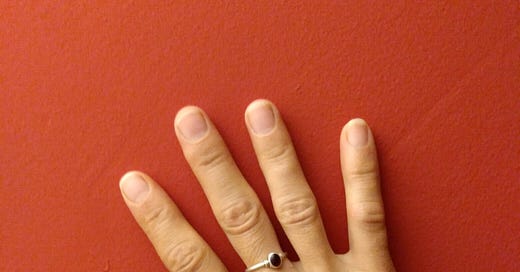Who I Am From
The shape of my hand tells the story of my maternal grandmother, and that of her father, just as the shape of my face tells the story of not only this same grandmother, but her daughter, my mother. My mouth is the same shape as my brother’s. This is what I think when I see my reflection or a picture of myself — that I am seeing not only my own reflection or likeness, but the people I come from.
My grandmother died when I was finishing Kindergarten — more than a grandmother, she was a second mother to us. I forgot the sound of her voice long ago, and some time in my early thirties I had the startling realization that she no longer appeared in dreams — I was losing her — so it is only seeing her face in the mirror as I trim my hair or brush my teeth that I have her still with me. As a child, any time we visited with her family — her siblings, cousins and in-laws, all I heard all day was “he looks so much like Colleen!” This near exact resemblance was especially noted when I was in a sassy or temperamental mood. “There go the eyebrows, just like Mom!” And when I would put my hands on my hips and glare with all of the indignation my four year old self could muster, it would leave my aunts and uncles in stitches, unable to finish the lecture because they couldn’t stop laughing at the face of their mother glaring out of a child.
When we were young, people often asked if my older brother and I were twins — something I never understood, and still don’t. It was not until I was twenty-five and the baby fat disappeared from my face that I began to see the features we share. By the time the shape of my mouth showed me my brother’s, I was no longer so determined not to be compared to him, and could embrace the similarity — could enjoy him smiling back me during the long gaps between visits. A few years ago, talking to my mother on the phone, she was noting some of the personality traits we share: curiosity, passion, arrogance, charm and an impatience with stupidity that has often led our mouths to get ahead of our brains. When I was ten or fifteen or twenty-five, I would have balked at such a statement, but at thirty-five, I felt more intrigued to be so similar to someone without being able to see it, and drawn to ask myself how well do we really know ourselves, after all?
I have lived for the last twenty years at a distance from my family — seeing them peering out of shared features keeps them close, closes the distance and reminds me that we are, all of us, intertwined — not the complete individuals we believe ourselves to be. Not the solitary masters of our destiny, but interdependent as the constituent elements of all that exists in our universe: tree, person, horse, forest, butterfly. Each coming from another, inseparably tied, despite the seeming autonomy of El Capitan, the water falling over Niagara or self. Now I live at an even greater distance, the greatest yet in all the years of miles between us — from where my family lives, from where those who have already passed lie buried — and as my hands learn new skills and my mouth a new language, we do it together — all of us, and I am not on this lovely journey alone, but have these stowaways here with me. My hands running through the olive branches give life to my grandmother and great-grandfather. My face turning brown in the sun is the gleaming heart-shaped visage of my mother and grandmother, sweaty, covered in saw dust and smiling, and my mouth — jumping from Portuguese to French and back again and sometimes confusing the two in a marvelous mess is the mischievous grin of my brother — delighted to be on this adventure, even with the linguistic clusterfucks. Though I am now alone in a foreign land, every day the shape of another’s hand or mouth or cheekbones being my own calls to me with the voice of the familiar. Here they are — my family — my people. Who I am. Who I am from.




